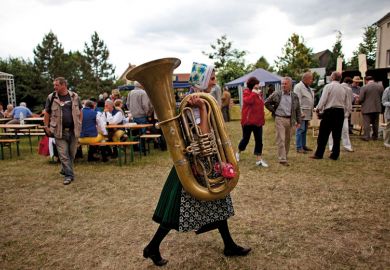German governments’ main tool for fixing gender inequality at universities has been reshaped to make it more accessible to the smaller institutions that missed out on earlier rounds.
Changes to the fourth iteration of the female professors programme were agreed by science ministers from Germany’s federal and regional governments at the beginning of November. It will get €320 million (£279 million) to fund positions and university gender equality activity from 2023-30, €120 million more than the last round.
Deputy chair of the ministerial meeting (GWK), Bavaria’s science minister Markus Blume, said that by extending the programme until 2030 smaller and medium-sized universities would “now have more opportunities to participate”.
Universities’ gender equality ideas will be judged “taking into account the specific situation of the respective university and in relation to type and size”, according to the programme sketch agreed by ministers.
Some of Germany’s other major funding programmes, such as its Excellence Strategy, also have gender equality components. That has meant that the larger universities that do well in them have tended to bag funding for female professorships too, said Lena Weber, who helps lead the Centre of Excellence Women and Science, part of the Leibniz Institute for the Social Sciences.
“Those universities who had been successful in the excellence initiative, they had already agreed gender equality concepts to make an application for the female professorships program, and this has been an advantage for them to become successful in this program,” she told Times Higher Education. “They’ve tried to counteract this development, they increased the calls and extended delivery dates so there’s more chance for every university who wants to show up regarding gender equality.”
The proportion of women professorships has risen from 8.2 per cent in 1995 to 26.3 per cent in 2020, according to GWK data. “Every evaluation of each round of the female professorship programme shows it is very effective and this is the reason the next round is pushed forward with a big bunch of money for eight years,” said Dr Weber.
But the impact has not been uniform across disciplines, and like much of Western Europe, Germany still has poorer representation of women in science, technology, engineering and mathematics (STEM) subjects. The proportion of women professors in the humanities rose 26.6 percentage points from 1995 to 2020, while in the natural sciences and mathematics the shift was 16.8 percentage points and in engineering just 11.5.
The fourth round of the programme will focus more on under-representation within disciplines. Dr Weber said STEM departments tended to blame a poor supply of suitable candidates and noted that this round would also look more closely at recruitment processes. “There is still more potential to look on different networks and to open up invitations to have an active appointment process,” she said.
The governments want Germany’s professoriate to reach gender parity by the programme’s end in 2030, but the high proportion of male grantees on earlier career tenure-track problems show that the target will not be hit with a single programme, Dr Weber said. “We will get to a certain point where other political decisions are necessary for postdocs. We have to change something structural in the whole country, the whole system.”
Register to continue
Why register?
- Registration is free and only takes a moment
- Once registered, you can read 3 articles a month
- Sign up for our newsletter
Subscribe
Or subscribe for unlimited access to:
- Unlimited access to news, views, insights & reviews
- Digital editions
- Digital access to THE’s university and college rankings analysis
Already registered or a current subscriber?








